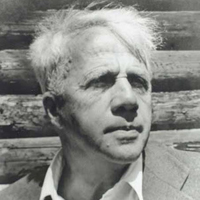Design by Robert Frost: Summary and Analysis
One of the most difficult poems, Design, an Italian sonnet by Robert Frost was published in 'A Further Range' in 1936. The sonnet is the expression of the poet's surprise over the mysterious existence of the world surrounded by omens and evil designs. According to a critic, ‘this is a poem of finding evil in innocence, a song of experience, though the voice is hardly that of Blake's childlike singer.'

Robert Frost (1874-1963)
The poet has drawn the picture of a fat and white dimpled spider which had caught hold of a moth like the white piece of the cloth on a flower called white heal-all. This simile has been used to indicate the white color of the moth. All these three things – spider, heal-all flower, and the moth are shown to be white. All these three white creatures and flower are brought together for some terrible reason. The terrible reason is a dark design of death or we can say the food chain in a positive term.
By bringing all these white things together, the speaker is trying to highlight the food chain lying in the nature. The moth has gone there in search of the juice of heal-all flower and spider has gone there in search of the moth. One day, even the spider will become the food for the flower. All these things of the universe are interconnected. The nature has designed us to be interdependent. Even living thing and being survives upon each other. Nature has already designed this interconnection.
The "heal-all" is a common country plant supposed to have healing properties: it is almost always blue in color. The poet has found a strange white variety and stranger still, attained to it a white spinner, "a snow-drop spider", holding a white moth, completing a pattern of whiteness. Here, in the world of chaos and darkness, there is purpose and design, "if (the poet speculates whimsically) design govern in a thing so small."
The white color is generally a symbol of purity and innocence, but in this poem this color has been contrasted with its meaning. The white color of the wicked flower heal-all (an ironic name) and the white natural born killer spider bring forth the image of an actual horror scene and the innocence ness of the white color does not matter here. So, in this respect, white color in this poem has been used as a symbol of decay, death and destruction. It is the design of the god to bring them together and it is also the dark design of nature to turn blue color heal-all flower into white, black color spider into white and the moth into white. These three characters of death and disease are at the same place like the ingredients of witch’s broth. This image does not bring the idea of life enhancing, but the image of destruction, cruelty and dependency. By showing everything white so cruel and horrific, Frost infers that darkness is everywhere, even under the hide of so called innocent people. Humanity is vulnerable as the moth in the poem.
Design is, beyond doubt, a difficult and ambiguous poem. It is rich in symbolic interpretation. In the words of Thompson, "For various and complicated reasons, his fluctuating and ambiguous viewpoint mocks, at times, any complacent notions concerning a benevolent design in nature. One of his sonnets which has occasionally been singled out for particular praise is a dark study in-white, ambiguously entitled ‘Design’.”
Taken out of context, the sonnet might seem to carry overtones more ominous than the context of Frost's other poems actually permits. By contrast, if this sonnet is considered in relation to the other poems, it suggests not so much a mood of depressed brooding over "the design of darkness to appall" but rather a grim pleasure in using such a peculiar exemplar for challenging and upsetting the smug assurance of complacent orthodox belief concerning who steers what, where, and how. Yet this sonnet resists even that much reduction. For Frost, the attempt to see clearly, and from all sides, requires a willingness to confront the frightening and the appalling even in its darkest forms?' The poem, presented in its entirely as above, follows the strict structure of a good sonnet.
Speaking of its artistic excellences, Reuben A. Brower remarks, "Few poems by Frost or more perfectly and surely composed, few where the figure in the mind and in the ear are better matched." There are "the daring use of tone end-rhymes," "the surprising and apt use of the many double and triple stresses on successive syllables", and the weighting of rhythm evoking seemingly slight and charming images."
Related Topics
The Death of the Hired Man: Summary and Analysis
Neither Out Far nor In Deep: Summary and Analysis
West Running Brook: Summary and Analysis
Stopping by Woods on a Snowy Evening: Analysis
A Considerable Speck: Critical Analysis
Mending Wall: Summary and Analysis
Home Burial: Summary and Analysis
After Apple Picking: Summary and Analysis
The Road Not Taken: Summary and Analysis
Fire and Ice: Summary and Analysis
Nothing Gold Can Stay: Summary and Analysis
Acquainted with the Night: Summary and Analysis
The Gift Outright: Summary and Analysis
 |
bachelorandmaster.com |